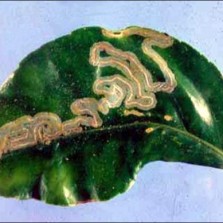
QUESTION: What is causing my citrus leaves to curl? JB
JORDI: I have received nearly a dozen calls on this same problem and although I have addressed it in this column before, it appears to be worth repeating.
Please bring all the citrus samples into the Extension office in sealed freezer bags as there are insects and diseases such as canker and citrus greening we do not want to spread to other trees.
I can generally diagnose most citrus problems through the bag. The leaf problem is caused by a small leaf mining moth, Phyllocnistis citrella Stainton, or the citrus leafminer (CLM).
Citrus leafminer (CLM) was found in late May 1993 in several citrus nurseries in south Florida. Since that time, CLM has been found everywhere in Florida where citrus is grown. Adults of the CLM are minute moths (4 mm wingspread) with white and silvery iridescent scales on the forewings, with several black and tan markings, plus a black spot on each wingtip. Adults generally are so small in fact, people barely notice them. They are active mostly during the day but have been known to continue their normal activities in the early evening hours.
Adults live for only a few days but in Florida generations are produced about every three weeks. They are not easily controlled using chemicals as they burrow between leaf and stem tissue and are therefore protected. They will actually fold a portion of the leaf over themselves to pupate.
I take great pleasure in breaking them out of the leaf fold and destroying them. If that is too gruesome for you then consider lightly pruning the infected leaves. The pruned leaves should then be bagged and destroyed to help manage the insect populations.
A predatory wasp, encyrtid parasitoid, Ageniaspis citricola, was introduced from Australia to Florida in 1994-95, and seems to be a key element in suppressing this leafminer to an acceptable level. The good news? This moth does not transmit disease, although it does make the tree look terrible. For more information on this insect, check out this University of Florida publication.

543350 U. S. Highway #1
Callahan, Florida 32011
E-mail: [email protected]
Phone: 904-491-7340
